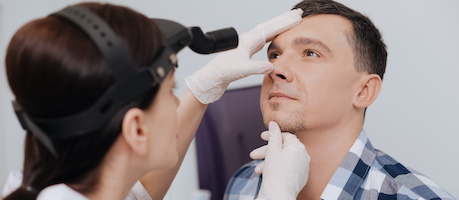Our audiologists employ a variety of methods for identifying and diagnosing hearing loss in adults and children. These include pure tone assessment, speech testing, evaluation of the middle ear system, and otoacoustic emissions.
Middle ear assessment can include tests such as tympanometry. Tympanometry provides information about how the middle ear is functioning. It does not not provide information about hearing acuity, but helps to detect any changes in pressure or mobility of the middle ear system. It can be used to help diagnose the type of hearing loss.
Pure-tone testing determines the faintest tones a person can hear at selected pitches or frequencies, from low to high. This test can be conducted in two ways; air conduction or bone conduction. For air conduction assessment, earphones are worn so that information can be obtained for each ear. Sometimes, use of earphones is not possible, such as when a child refuses to wear them. In these cases, sounds are presented through speakers inside a sound booth (called sound-field testing). Air conduction is the traditional path sound is heard, where a sound enters the ear canal, is transmitted through the eardrum and middle ear system to the inner ear and hearing nerve.
Bone conduction testing directly tests the inner ear and hearing nerve, without using the middle ear system. Sound is presented through a small vibrator placed behind the ear (or on the forehead). The signal reaches the inner ear (or cochlea) directly through gentle vibrations of the skull. The testing can measure responses of the inner ear/hearing nerve to sound, independently of the outer and middle ears and can help determine the type of hearing loss being measured.
In order to obtain Pure-tone testing results, the patient will be asked to respond to sounds in a variety of ways, such as raising a finger or hand, pressing a button or pointing to the ear in which they hear the sound or simply by stating yes, whenever they hear tones. During the test, each test frequency (or pitch) is varied by intensity (or loudness) to determine the softest sound that can be heard. Thresholds for each ear are plotted on a graph known as the “audiogram”.
The Audiologist will also conduct tests of listening and speech. These results are also recorded on the audiogram. One test that the audiologist conducts during a hearing test is the Speech Reception Threshold (SRT). This test aims to find the softest level of speech someone is able to hear. This test is used with older children and adults, and helps to confirm the reliability of pure-tone test results. The SRT records the faintest speech that can be heard half the time. Then the audiologist will also conduct a word recognition score (WRS), this determines the ability to accurately repeat a specific list of words at a comfortable volume. Speech testing may be conducted in a quiet and/or noisy environment. Difficulty understanding speech in background noise is a common complaint of people with hearing loss, and this information is helpful.
Hearing loss is measured in decibels (dB) and is typically described in the following general categories:
- Normal Hearing (0 to 20 dB HL)
- Mild Hearing Loss (20 to 40 db HL)
- Moderate Hearing Loss (41 to 55 db HL)
- Moderately-Severe Hearing Loss ( 56 to 70dB HL)
- Severe Hearing Loss (71 to 90 dB HL)
- Profound Hearing Loss (greater than 91 dB HL)
Testing Hearing in Children
Advanced Hearing Services has Doctors of Audiology that specialize in diagnosing and treating pediatric hearing loss. Children present different challenges and require alternative testing methods than adults.Our Doctors of Audiology employ specific types of hearing testing methods to assess children. These tests can include, evoked otoacoustic emissions, visual reinforcement audiometry and conditioned play audiometry.
Evoked Otoacoustic Emissions (OAE) is a test that uses a tiny, flexible tip that is inserted into the ear canal. Tones are sent through the tip into the ear. There is a microphone in the tip that records the responses from the ear. When an ear is working well, it is capable of sending out a signal in response to these sounds, which are known as otoacoustic emissions. These emissions are sometimes referred to as “cochlear echos”. The presence of these emissions are an indication of a functional inner ear. This test is painless and is usually completed within a minute. Given the very quiet nature of these emissions, children do need to remain fairly quiet and still during testing.
Visual reinforcement audiometry (VRA) testing is a type of screening method for young children. For VRA testing the child is trained to look towards a sound source, including speech and tones. When the child gives the correct response (e.g. looking toward the source of the sound when it is presented), the child is rewarded through a visual reinforcement such as watching a toy that moves or a flashing light. This type of testing is typically done in the soundfield, and sometimes under headphones (if a child will tolerate wearing headphones).
Conditioned play audiometry is used for older children such as toddlers and preschoolers. The child is trained to perform a specific action each time a sound is heard. Such as making an animal sound, putting a block in a box, placing pegs in a hole, putting a ring on a cone, etc. This type of testing can be used to obtain hearing thresholds for speech and for tones.
Infant (under the age of six months) diagnostic hearing testing is not performed at this practice. It is recommended that all babies’ hearing be screened by 1 month of age, and diagnosed by 3 months of age so that treatment can begin before the baby is 6 months old, as it is such an important time for speech and language development.



